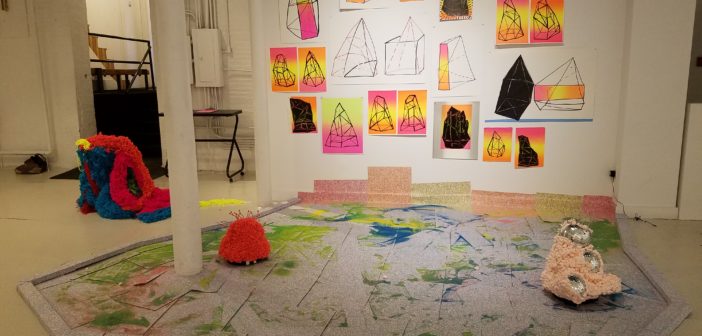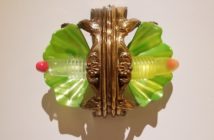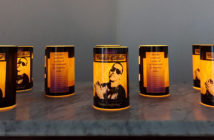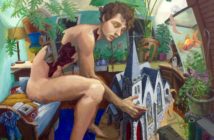In a self-described “series of dubious choices” and “earnest efforts,” artists Emmy Bright and J.R. Uretsky have populated the Distillery Gallery’s space with vibrantly hued sculptures, colorful sand, and self-effacing text in their show Feeling Feeling. True to its title, the exhibition is a tangle of enervating emotions and self-deprecation.
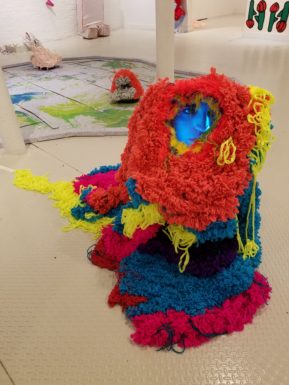
Photograph courtesy of Frank Redner.
A bright mound of crocheted yarn greets the viewer on entering. At the top, a small television set peeks out through the bright strands, acting as the lone anatomical reference. A variety of faces flicker across its screen, some dazzled and others blank. The glib gaze of Edward Cullen, famed glittering vampire of the Twilight series, can be spotted among them. A focal point of misguided and acute adolescent desire, Cullen can supplement his own vitality by draining others of their blood, though by abstaining he cultivates a hollowed social distance from his peers. Twilight lore aside, the surrounding works point out their own lack and hollowness, punctuated by languid pleas for attention and vindication. They ooze and slouch, their vibrant colors belying their bleary, vulnerable states.
Atop an archway in the back perches a gaping maw comprised of a blue carapace riddled with holes and uninflated yellow balloons. A pink thread punctuated by a delicate bell is strung through the creature’s hide and wraps around a nearby pipe, recalling an anglerfish’s glowing filament. A nearby banner with lettering in black fired clay reads, “SAY MY NAME.” Whether a command, a dare, or a plea, the text underlines the sculpture’s need for some small token of validation. Its partner wilts beneath it, a red and blue flower-like object relying on the wall for support. It seems to be ignoring its companion, and in so doing the flower tacitly substantiates the former’s need for acknowledgement.
Near our would-be anglerfish sags a mattress-like form on the floor. With two nubs resembling stubby legs, its iridescent body slumps to the right, like a partier passed out on the street. What the party was celebrating is anyone’s guess. It is clearly a party no longer, especially for the nearby sock-puppet who has puked its fuzzy contents onto the floor.
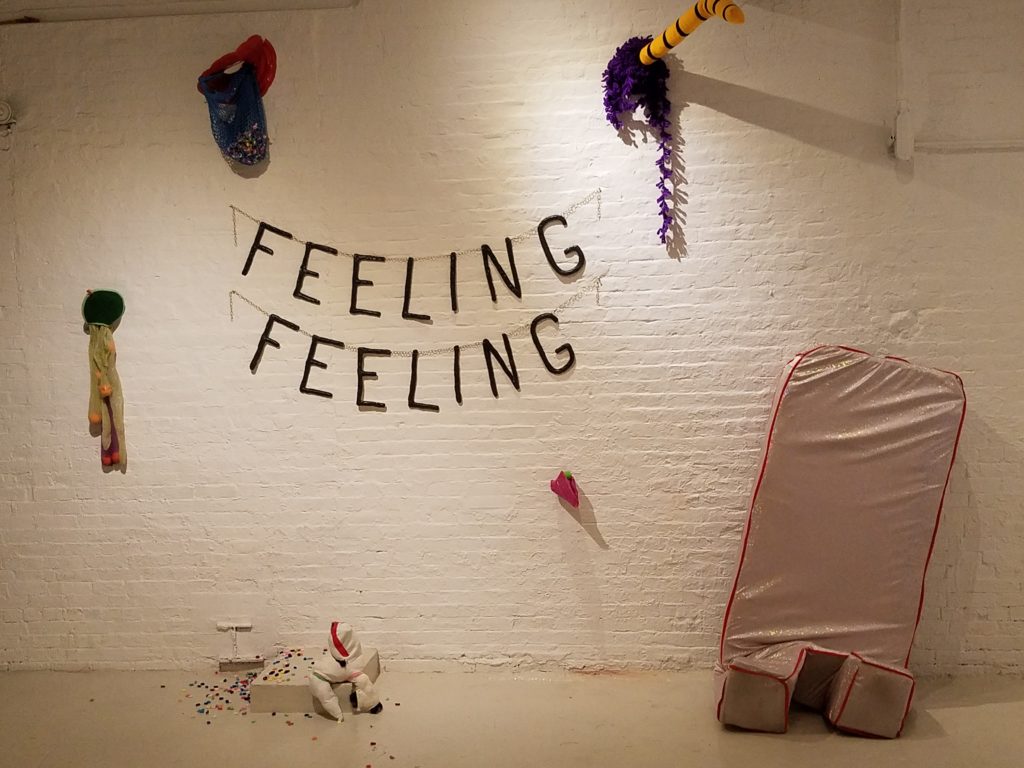
Photograph courtesy of Frank Redner.
The show is a spectacular wreck and it is difficult to look away; what on the surface seems like a party deteriorates into striking displays of exhaustion. We want to figure out what led to this showcase of deflation, much like how we analyze our own inflated feelings.
Text is integral in reining in the fluorescent palette. The mattress and fuzzy sock are accompanied by another banner that reads “FEELING FEELING.” The meaning is ambiguous. Whether it is stating that feelings themselves feel, or describing an emotional state of being, the banner bears the responsibilities of being both title card and unreliable narrator. Whatever the dynamic, the feelings self-propagate, manifesting as these colorful homunculi and banners.
In the rear chamber is a messily drawn Venn diagram; the labeled circles of “Bullshit with your mom,” “Bullshit with my mom,” “PUSH ME AWAY,” and “PULL ME CLOSE,” collide and contort, as if the illustrator threw this diagram together under extreme duress. Underneath it rests a fabric rind on a pink paper runner. Its interior is lined with brilliant sequins. What may be read as giddy and vibrant instead bristles and stews, sheltered from sight.
Finally, the spectacle of the central display is impossible to ignore. In a pit of colorfully printed paper and vibrant sands are two sculptures atop off-brand Roomba vacuums. One is made of orange yarn and wiry antennae, with printed ruffled fabric softening its edges. The second is comprised of segmented disco balls amidst pink packing peanuts. The pink Styrofoam resembles a seated figure, its own antennae forming a consolatory crown.
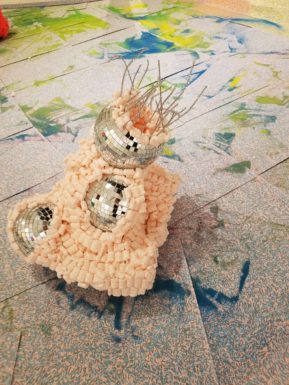
Photograph courtesy of Frank Redner.
When activated, the two vacuums jolt into action, seeking out the colorful sand strewn on the floor. However, their mission is a doomed one. As they pick up more particles, others are pushed out through a hole drilled in their internal waste bins. As the vacuums gather sand, they spew litter, creating a messy wake that is impossible for them to fully clear. This duo inevitably engenders their own distress. Feasibly they could go on until their batteries empty, bleeding out all the while and never moving forward in their task. Once the task has begun, however, stopping would mean quitting.
The exhibition is fascinating to unravel, both emotionally and intellectually. Its jarring tongue-in-cheek aesthetic belies the serious emotional surges and lingering echoes of thought and desire. Looking at the amorphous forms becomes an exercise in amateur diagnosis as we ponder our own mental health in tandem, adding personal relevance. Mental stress, after all, needs management. It’s a full-time job. Even the act of managing one’s emotions and thoughts becomes its own stressor, a pile of sand one cannot ignore or hope to fully clear away. And a few grains are always left behind to abrade.
Feeling Feeling will be on display at the Distillery Gallery until October 14th.

